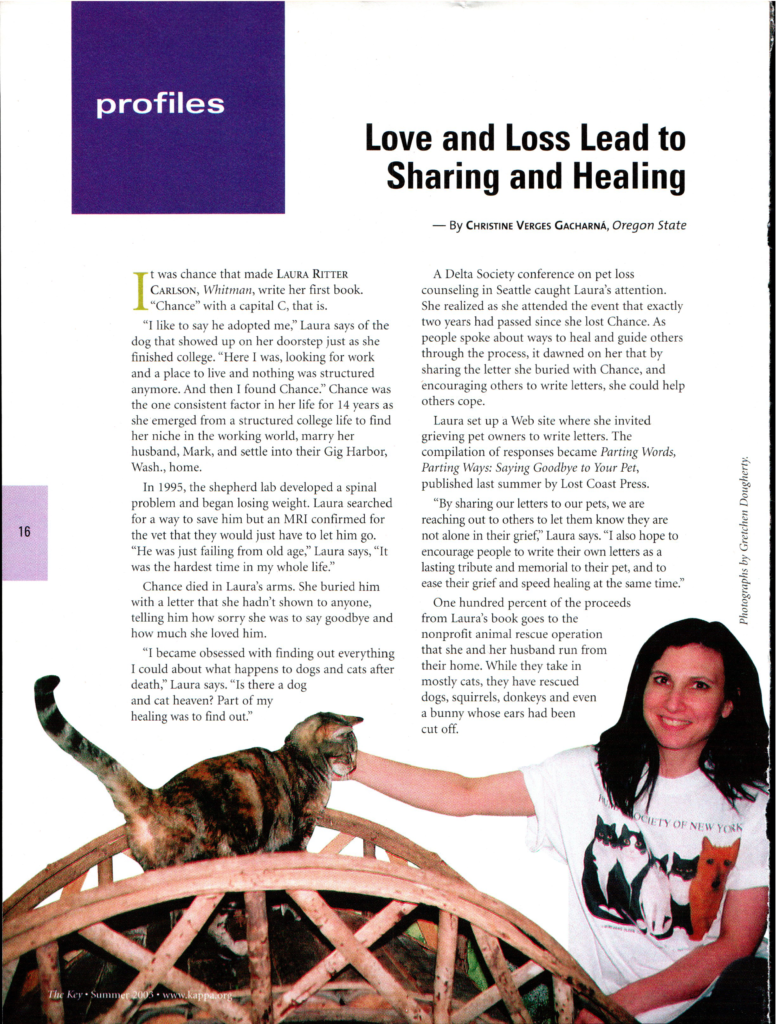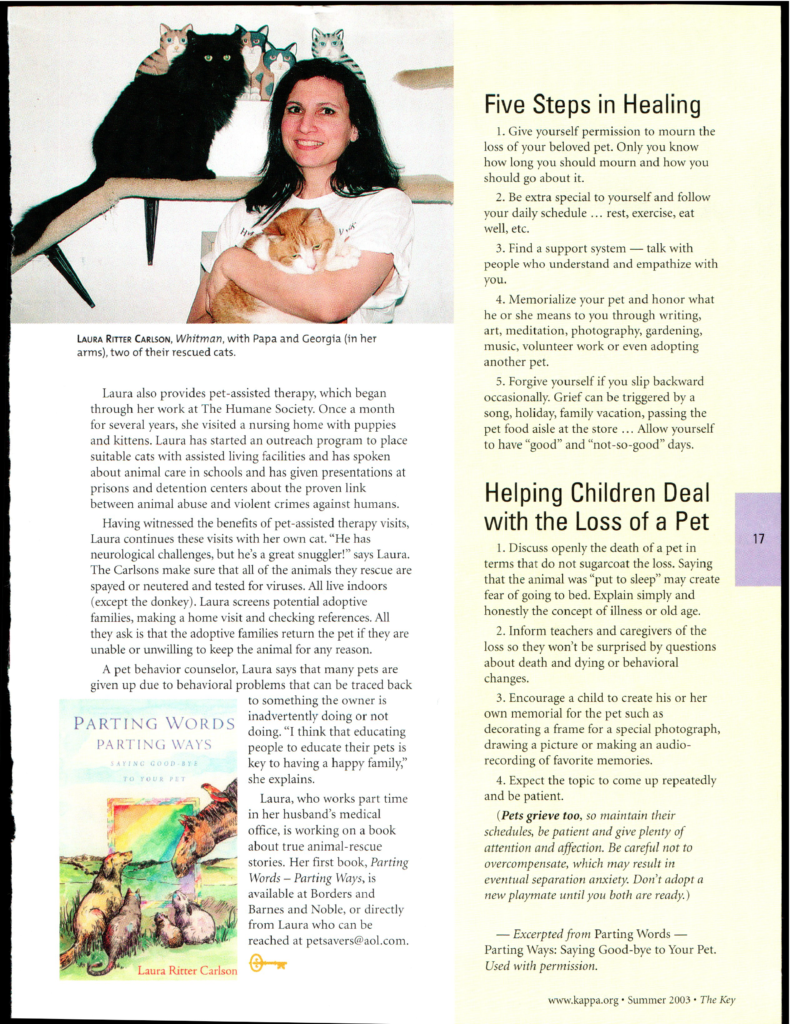Love and Loss Lead to Sharing and Healing
It was Chance that made Laura Ritter Carlson write her first book — “Chance” with a capital C, that is.
“I like to say that he adopted me,” Laura says of the dog that showed up on her doorstep just as she finished college. “Here I was, looking for work and a place to live, and nothing was structured anymore. And then I found Chance.”
Chance was the one consistent factor in her life for 14 years as she emerged from structured college life to find her niche in the working world, marry her husband, Mark, and setting into their Gig Harbor, Wash., home.
In 1995, the shepherd lab developed a spinal problem and began losing weight. Laura searched for a way to save him but an MRI confirmed for the vet that they would just have to let him go. “He was just failing from old age,” Laura says. “It was the hardest time in my whole life.”
Chance died in Laura’s arms. She buried him with a letter that she hadn’t shown to anyone, telling him how sorry she was to say goodbye and how much she loved him.
“I became obsessed with finding out everything I could about what happens to dogs and cats after death,” Laura says. “Is there a dog and cat heaven? Part of my healing was to find out.”
A Delta Society conference on pet loss counseling caught Laura’s attention. She realized as she attended the event that exactly two years had passed since she lost Chance. As people spoke about ways to heal and guide others through the process, it dawne on her that by sharing the letter she buried with Chance, and encouraging others to write letters, she could help others cope.
Laura set up a website where she invited grieving pet owners to write letters. The compilation of responses became Parting Words, Parting Ways: Saying Goodbye to Your Pet, published last summer by Lost Coast Press.
“By sharing our letters to our pets, we are reaching out to others to let them know they are not alone in their grief,” Laura says. “I also hope to encourage people to write their own letters as a lasting tribute and memorial to their pet, and to ease their grief and speed healing at the same time.”
One hundred percent of the proceeds from Laura’s book goes to the nonprofit animal rescue operation that she and her husband run from their home. While they take in mostly cats, they have rescued dogs, squirrels, donkeys, and even a bunny whose ears had been cut off.
Laura also provides pet-assisted therapy, which began through her work at The Humane Society. Once a month for several years, she visited a nursing home with puppies and kittens. Laura has started an outreach program to place sustainable cats with assisted living facilities and has spoken about animal are in schools and has given presentations at prisons and detention centers about the proven link between animal abuse and violent crimes against humans.
Having witnessed the benefits of pet-assisted therapy visits, Laura continues these visits with her own cat. “He has neurological challenges, but he’s a great snuggler!” says Laura. The Carlsons make sure that all of the animals they rescue are spayed or neutered and tested for viruses. All live indoors (except the donkey.) Laura screens potential adoptive families, making a home visit and checking references. all they ask is that the adoptive families return the pet if they are unable or unwilling to keep the animal for any reason.
A pet behavior counselor, Laura says that many pets are given up due to behavioral problems that can be traced back to something the owner is inadvertently doing or not doing. “I think that educating people to educate their pets is key to having a happy family,” she explains.
Laura, who works part time in her husband’s medical office, is working on a book about true animal-rescue stories. Her first book, Parting Words, Parting Ways is available at Borders and Barnes and Noble, or directly from Laura.
Five Steps in Healing
- Give yourself permission to mourn the loss of your beloved pet. Only you now how long you should mourn and how you should go about it.
- Be extra special to yourself and follow your daily schedule … rest, exercise, eat well, etc.
- Find a support system — talk with people who understand and empathize with you.
- Memorialize your pet and honor what he or she means to you through writing, art, meditation, photography, gardening, music, volunteer work, or even adopting another pet.
- Forgive yourself if you slip backward occasionally. Grief can be triggered by a song, holiday, family vacation, passing the pet food aisle at the store … Allow yourself to have “good” and “not-so-good” days.
Helping Children Deal with the Loss of a Pet
- Discuss openly the death of a pet in terms that do not sugarcoat the loss. Saying that the animal was “put to sleep” may create fear of going to bed. Explain simply and honestly the concept of illness or old age.
- Inform teachers and caregivers of the loss so they won’t be surprised by questions about death and dying or behavioral changes.
- Encourage a child to create his or her own memorial for the pet such as decorating a frame for a special photograph, drawing a picture, or making an autio-recording of favorite memories.
- Expect the topic to come up repeatedly and be patient.
(Pets grieve, too, so maintain their schedules, be patient, and give plenty of attention and affection. Be careful not to overcompensate, which may result in eventual separation anxiety. Don’t adopt a new playmate until you both are ready.)


Originally published in The Key, Summer 2003